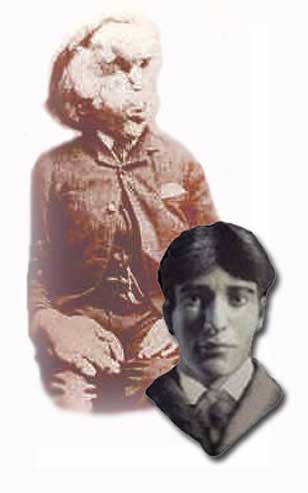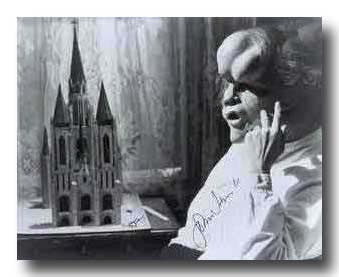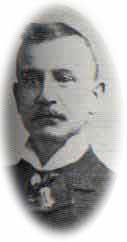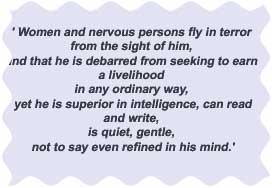Anyone who has read the story of Joseph Merrick, could not fail to be captivated by the incredible sensitivity of this man and courage. He was an intelligent person, not only be able to write and speak eloquently, but also able to play. The ability to read was a rarity among the poorest classes of the 19th century, and therefore we can also admire Joseph for his inner struggle to become educated and to extricate himself from his poor background and circumstances.
Born in Leicester, England, in 1862, Joseph began to develop tumors on his face before his second birthday.
Joseph lived with his mother (Mary Jane Merrick); younger brother (William Arthur) and sister (Marion Eliza) during his childhood. His little brother, John Thomas, died at 3 months (April to July, 1864). Mary Jane died May 19, 1873 of bronchial pneumonia when Joseph was just 11. “Unfortunately, by all historical accounts, no actual photograph of the Mother of Merrick would have survived the test of time.” * It is interesting that, according to testimony from family and eyes, as she was “paralyzed”. The picture presented in the film, “… is that of Phoebe Nicholls (the actress who plays her mother). ” *
Joseph had lived in several places, one of them was a “Workhouse, where he was forced to work for subsistence, (despite its appearance). Another place, lived with his father and stepmother. His father certainly did not really want it and there were lines around her countless more. As for the stepmother was concerned, Joseph was just an embarrassment and inconvenience and it finally gave her husband the ultimatum of, “it’s him or me.” If they would give Joseph a roof over their heads, they should at least him to work for it. He was forced to “Street Hawk”, the sale of black shoes along with cold, cobbled streets nearby. It was hard enough for him to walk on flat surfaces, but the blocks were a real danger. Its shape has been a source of great amusement for dozens of children who follow him from street to street, laughing at him and shouting names cruel. Her condition health quickly worsened bulbous, cauliflower raw rose from the head and body, and his right hand and forearm became a useless club.
In later life, (prior to its participation in the Whitechapel Hospital), Joseph was mostly unemployable, destitute and stripped of all his self-esteem by the people’s ignorance of the day. He was ready to accept any job they offered him a crust.As ultimately, he took a job as “abnormal” on one side the show. However, “there was not hit rituals, and neither has it been removed to hospital in London (this part is a product of artistic lisence Lynch – I’m certainly not knocking the movie of the Elephant Man “- he was superb and I am in complete recommended). I devoted a page to the film and there is a trailer of the movie too.
The entrepreneur Tom Norman (right), who took Merrick under his wing, was anything but the bytes monster portrayed in the movie. In fact, he treated with great care Merrick – after all, Joseph was his livelihood. Autobiography of Joseph three-page makes no mention of beatings or mistreatment. In fact, experience has pretty well off (he had amassed some 200 pounds – that was one heck of a lot of money back then).
Surgeon Frederick Treves (later to become Sir Frederick Treves) Whitechapel Hospital (now the Royal London Hospital), came to hear of Mr. Merrick and visited him. He considered private to 123 Whitechapel Road, opposite the hospital, then Whitechapel – now an Indian Saree Shop (left). “Treves have expressed interest in scientific / medical in Merrick, presenting it before the London Pathological Society (December 2, 1884), and then sent him on his way.
Joseph came to London Liverpool Street Railway Station in June 1886. He was to earn a living in the only way he knew how, as a monster. Freak shows had become outlawed in the UK at that time, then he has worked across the Channel in Belgium. Austrian showman, unrelated Tom Norman, Joseph flew blind, and left him destitute in Belgium. The police found Dr. Treves business card in the pocket of Joseph.
After being taunted by children constantly, and trying to escape a number of acrimonious adults, Joseph was crumpled on the floor in a heap, hungry and gasping for breath. [Simple words can not describe this way better scene.The the reader can understand, is to watch the movie “Elephant Man”, as it is almost precisely describes the way things were at the station]. Joseph was taken to the London Hospital (Whitechapel Hospital). He was taken directly to an isolation ward of the hospital, so as not to alarm the other patients. Some time later (unknown when), plans were made to obtain a final home and resting place for Joseph. In those days, hospitals have the policy to never provide their beds for the terminally ill. ” A permanent home was what was needed. Through the work of Treves with Joseph, they both had become a celebrity. Philanthropists and well-makers all over Britain and Europe have been written for the Hospital in Whitechapel (London Hospital), offering all the assistance sorts, in addition, large amounts of money were offered to care for Joseph. Enormous pressure was placed on the Whitechapel Hospital to give this “child of England” a permanent home.
A house was donated. The ground floor of the east wing of the Hospital became the home of Joseph STANDING. The best years of adult life of Joseph was spent in hospital in London, supported by his friend Dr. Treves and accompanying nurses. Joseph felt respected and loved. It was very comfortable. Its small annex Bedstead Square was adapted to personal needs. A specially built chair was built by the chief engineer, William Taylor. If ever there was a true example of human kindness, he was here. They went against all the rules to help our beloved Joseph.
Rare photograph taken from the film, signed by John Hurt. Hurt played the role of Joseph Merrick in “Elephant Man”.
Joseph was not able to mingle in the finest circles because of its appearance. Even when he was an autodidact, he had to rely largely on his imagination of social events. His dignified attitude would certainly not inferior to that of an English gentleman in a valid measurement of the time, and his manners equal if not superior at times, those of more well to do backgrounds. Mostly, it was deliciously childish, tending to oversimplify things. Finally many hours away from home, often alone, (a very small price to pay for safety and comfort), he found ways to use the wonderful imagination. The Church of the card.
Joseph built a church card kit of German origin .. “Man of the elephant” The film shows Joseph the building, based on its view of limited near the church of St. Philips. It was not the case – it came in a kit form very ‘fiddly’. One can only imagine the difficultiees he had, like a hand and arm was unusable. Read more
Joseph died April 11, 1890. There was a small and very private ceremony. Shortly after, casts were taken of his body for scientific examination. Samples were taken over and preserved in formaldehyde. Unfortunately, they were destroyed during the Blitz of World War II. In addition, some parts were buried in an unmarked grave, (location unknown). Last but not least, its skeleton remains in the Royal London Hospital (Whitechapel). It stands vertically in a glass case. The bones are somtimes drilled into the possibility that someday, some “up and coming” science can make a name for himself / herself, finding something useful to extract. So far, nothing positive was found. The webmaster, Jeanette Sitton, when asked the hospital archivist, Jonathan Evans, if there was any consent document (signed by Joseph, saying he agreed to leave his body to science). It was said that to their knowledge, there is nothing to prove or disprove this authorization was given. Joseph was a devout Christian. So would he have wanted a Christian burial? We will never know.
Here’s something to note, and that is, speech Merrick has never been as clear as it was shown that more and in the movie, and although Trier and others have learned to make him understand with little hindrance, Treves had often to act as an interpreter for people who were not able to understand. He also noted that it is always difficult for foreigners to Merrick to understand it – everyone should aclimatise.
“It has been suggested that Sir Treves, suffering from memory loss caused by age, may have become confused about many facts when he published his memoirs in 1922. There is however, no historical evidence to support his name Joseph has never been anything other than Joseph Carey Merrick. *
original article–http://goo.gl/vHltL




